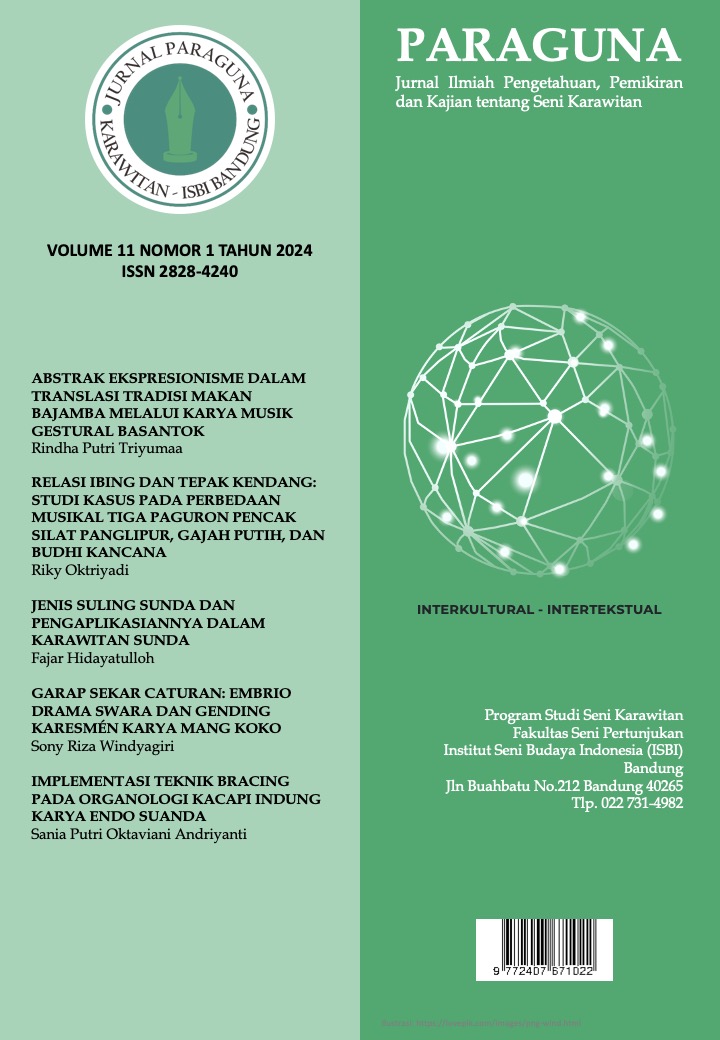Abstrak Ekspresionisme Dalam Translasi Tradisi Makan Bajamba Melalui Karya Musik Gestural Basantok
Keywords:
Basatok, Makan Bajamba, Gestur Musik, Abstrak, ExspressionismAbstract
This article explores the creative process behind the music work BASANTOK, inspired by the Makan Bajamba tradition of the Minangkabau community, and analyzes its connection with the principles of Abstract Expressionism. The creation process involves stages from analyzing the ritual, conceptualizing, and composing to evaluating and revising, with the goal of transforming and revitalizing cultural traditions through gestural music. Abstract Expressionism, with its emphasis on spontaneity and freedom in musical expression, creates an experience that allows listeners to engage emotionally and mentally with revitalized cultural values. This article demonstrates how music can serve as a medium for preserving and transforming cultural traditions while integrating Abstract Expressionist concepts to offer new perspectives in musical art
References
Akmal, Ahmad. (2013). Ekspresi Bentuk Simbolik Seni Ritual Makan Bajamba. Padang Panjang: Institut Seni Indonesia Padang Panjang Audissino, E. (2017). John Williams and contemporary film music. In L. Coleman & J. Tillman (Eds.), *Contemporary film music*. Palgrave Macmillan. https://doi.org/10.1057/978-1-137- 57375-9_14 Chung, A.J. (2019) ‘What is musical meaning? Theorizing Music as performative utterance’, Music Theory Online, 25(1). doi:10.30535/mto.25.1.2. Ciciliani, M. (2017). Music in the expanded field: On recent approaches to interdisciplinary composition. Darmstädter Beiträge zur Neuen Musik, 24, 23-35. Collin, F. (1997). Social Reality (1st ed.). Routledge. https://doi.org/10.4324/9780203047927 Devenish, L. (2021). Instrumental infrastructure, instrumental sculpture and instrumental scores: A post-instrumental practice. Music & Practice, 9. doi:10.32063/0906
Gozali, A. (2018). Dimensi Spiritual dalam Seni Lukis Abstrak Kontemporer Indonesia: Sejarah dan Wacana. Krausz, Michael. (2007). “Interpretation And Transformation Explorations In Art And The Self”. New York: Rodopi B.V. Meigalia, Eka. (2019). Mengenal TradisiLisan Minangkabau. Padang: LPPM Universitas Andalas Muhadjir, Noeng. (1996). Metodologi Penelitian Kualitatif. Yogyakarta: RAKE SARASIN Pudjasworo, B., Prasetya, H. B., Wayan Senen, I., HB Raditya, M., Rokhani, U., & Yudiaryani,Y. (2017). Karya Cipta Seni Pertunjukan. Salim, A., & Aprison, W. (2024). Pendidikan Multikultural Berbasis Kearifan Lokal. Jurnal Penelitian Ilmu Pendidikan Indonesia, 3(1), 22-30. Sriwulan, Wilma. (2020). Salawaik Dulang Perubahan dan Kontinuitas. Semarang: Lembaga Penelitian dan Pengabdian kepada Masyarakat (LP2M) Universitas Negeri Semarang
Sukerta, Pande Made. (2021). Wawasan Penciptaan Karya Seni. Surakarta: ISI Press Sunarto, Bambang. (2013). Epistimologi Penciptaan Seni. Yogyakarta: Idea Press Yogyakarta Sutiyono. (2022). Fenomenologi Seni. Yogyakarta: Arttex Syaputra, A., & Yohana, N. (2018). Makna Simbolik Prosesi Makan Bajamba Dalam Baralek Adat Minangkabau di Desa Baso Kabupaten Agam Provinsi Sumatera Barat. Jurnal Online Mahasiswa (JOM) Bidang Ilmu Sosial dan Ilmu Politik, 5(2), 1-13. Van Alphen, E. (2005). Art in mind: How contemporary images shape thought. University of Chicago Press.
Zulhadi, H. (2021). Adat Perkawinan Endogami Mayarakat Sade-Rembitan dalam Pandangan Hukum Islam. Jurnal Ulul Albab, 24(2), 76-79.
Downloads
Published
How to Cite
Issue
Section
Citation Check
License
Copyright (c) 2024 Rindha Putri Triyuma

This work is licensed under a Creative Commons Attribution-NonCommercial-ShareAlike 4.0 International License.
- Authors retain copyright and grant the journal right of first publication with the work simultaneously licensed under a Creative Commons Attribution License that allows others to share the work with an acknowledgement of the work's authorship and initial publication in this journal. Authors are able to enter into separate, additional contractual arrangements for the non-exclusive distribution of the journal's published version of the work (e.g., post it to an institutional repository or publish it in a book), with an acknowledgement of its initial publication in this journal. Authors are permitted and encouraged to post their work online (e.g., in institutional repositories or on their website) prior to and during the submission process, as it can lead to productive exchanges, as well as earlier and greater citation of published work.









